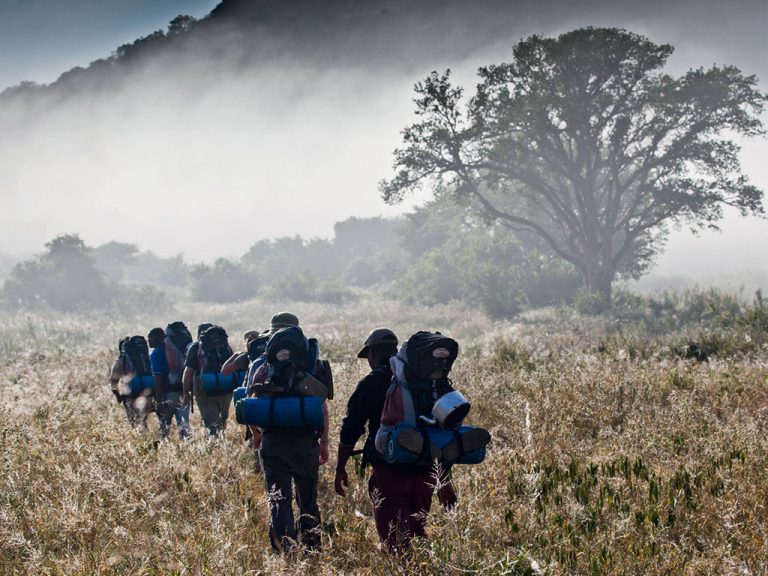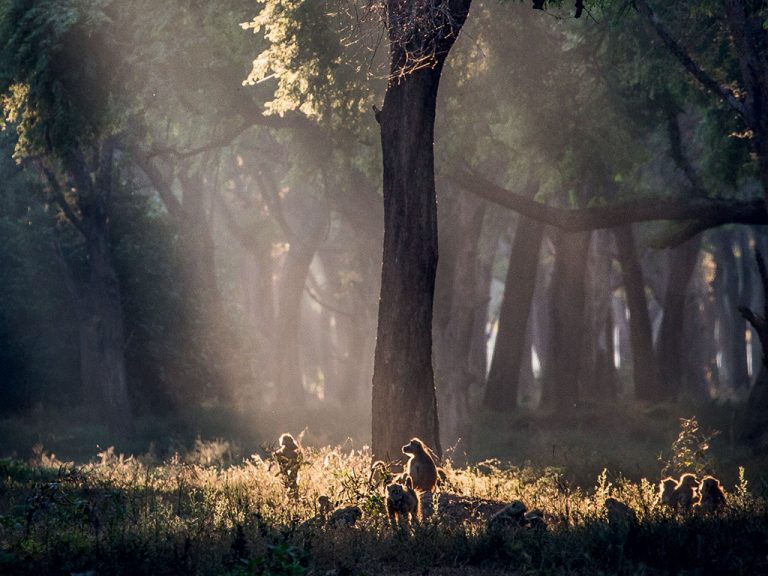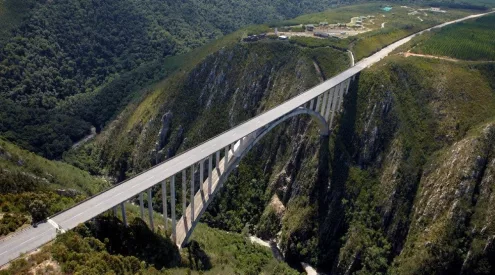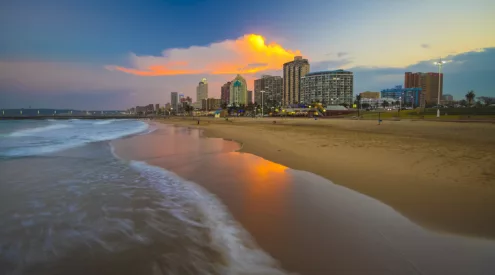It is often in moments when we are free and unfettered – out in nature or dancing with friends or communing with endless skies or standing rapt before a living, breathing, wild creature that could stop our heart in an instant – that we feel life is most exquisite.
Here are expert recommendations for bucket list winter wildlife encounters, by Don Pinnock (DP), Scott Ramsay (SR), Teagan Cunniffe (TC), Melanie van Zyl (MvZ), Sonya Schoeman (SS), Tyson Jopson (TJ).
1. Touch a sleeping rhino
Kwandwe, Eastern Cape

Rhino darting forms an integral part of the monitoring and conservation process. Image credit: Scott Ramsay
For most visitors to parks in Africa, the closest we will get to a rhinoceros is a good few metres away while sitting in a game-drive vehicle. At Kwandwe Private Game Reserve, you can join the vet and ranger team as they dart and notch the ears of their black and white rhinos. Led by reserve founder Angus Sholto-Douglas, visitors get a rhino-side view of the whole drama. As it succumbs to the sedative drug, the beast collapses in a sleepy state.
The vets get to work, which includes taking samples and inserting a tracking device into the horn. For guests, it’s a fascinating, up-close view of these huge, ancient creatures, which seem even larger when you’re standing right next to one.
Put your hand on its nostrils and feel the powerful breath. Feel the rough skin several centimetres thick. Touch the ears.
And that horn … a seriously impressive weapon made of common keratin that has now become the most expensive commodity on Earth.
Once you’ve experienced a rhino up close it’s harder to ignore the tragic poaching epidemic sweeping the continent. Suddenly, the whole thing becomes very personal. – SR
Do it: The experience costs R40000 for a group of eight (no under-16s). Accommodation is extra: from R8690 per person sharing, including all meals and house drinks, two daily game drives and guided walks. kwandwe.com
2.Walk this new trail
Kruger National Park, Mpumalanga

Armed rangers will guide you along Kruger’s newest trail, which is ideal for safe but close encounters with big game. Image credit: Melanie van Zyl
Walking Kruger is one of the wildest (and most exclusive) ways to spend three nights in the park. The newest option is the Mathikithi Trail in the Satara section, best known for its incredible game sightings. Even though it’s a busy part of the park, on this trail you’re guaranteed remoteness, tranquillity and a big bonus: no other people, as each trail caters to a maximum of eight.
The off the-grid camp stands below an isolated sandstone hill about six kilometres southwest of Satara, next to the N’wanetsi Creek. Although rustic, with shared ablutions, it’s comfortable and has spectacular sundowner views. The broken terrain around here is ideal for close but safe encounters with big game such as elephant and buffalo, who have scored out a well-marked network of natural paths. – MvZ
Do it: Each day’s walking is an average of five to six kilometres; relatively good fitness is recommended. From R4400 per person, including all meals, two walks a day and accommodation for three nights in tented cabins.
sanparks.org
3. Deep-chill with marine wonders
Chumbe Island, Zanzibar

The Chumbe reef is a protected sanctuary known for its diverse coral. Image: Teagan Cunniffe
Coral cities spread beneath you in terraces, fish clump together on their patios and dog-sized crayfish lurk in alleys. The water is warm and clear, about three metres deep, and you can dip down to inspect anemones, mushroom coral, clams and sea cucumbers, and hear whale song if you’re lucky. Guides explain what you’re seeing – somewhat like an underwater safari.
On land, the tropical dry forest grows on a bedrock of fossilised coral. Rare Aders’ duikers flit between shadows and coconut crabs crawl across the ground in the moonlight. Both day-trippers and overnight guests are assigned one of seven eco-cabins, a short stroll from the beach. For those who stay on, a magical three-course dinner is served below the lighthouse.
– TC
Do it: Day trips cost R1100 per person, staying overnight is R3550 per person. chumbeisland.com
4. Make eyes at a gorilla
Virunga National Park, DRC

The critically endangered mountain gorillas only live in the dense forests in the vicinity of Virunga mountains in Uganda, Rwanda, and the Democratic Republic of the Congo. Image credit: Scott Ramsay
When an adult gorilla looks one in the eyes, you remember what we all know yet often ignore: that we humans are sharing this planet with thousands of other species, and that our destiny is directly linked to theirs. Spending an hour with these endangered apes also makes you realise what’s at stake, not just here but in all of Africa and the Earth. The region around Virunga is politically volatile, but the park has not had any security incidents in 10 years with a tourist under their care. Compared to Rwanda and Uganda, Virunga’s gorilla experience is the best value for money, the least touristy and the most rewarding. – SR
Do it: A gorilla permit is from R3415 per person, accommodation in the park costs R3075 per person sharing, full board. visitvirunga.org. Getting there involves a flight to Kigali in Rwanda, then a road transfer via Goma. Contact local expert Alastair Kilpin to help arrange your trip. mammothsafaris.com
5. Hone your photography skills
iSimangaliso Wetland Park, KwaZulu-Natal

Loggerhead and leatherback turtles nest along the coastline of the iSimangaliso Wetland Park Image credit: Teagan Cunniffe
There is so much on offer in this World Heritage Site, starting with close-up rhino sightings from horseback, and a fair chance of spotting leopard. Watery viewings are good, too – board a boat at St Lucia and grumpy hippos pop up alongside you, while fish eagles, cormorants and flamingos are attracted by the fish at the estuary. Bring your telephoto lens, preferably with a focal range longer than 300mm, to get the best out of these experiences. The coastline lends itself well to long exposures. Then on to the fresh water in the northern parts, where drones love the narrow channels that feed into wide lakes.
Do it: Utshwayelo Lodge is closest to the Kosi River Mouth. From R330 per person sharing a safari tent. kosibay.africa. Kosi Forest Lodge offers boat trips through the channels. From R2170 per person sharing. isibindi.co.za. For info on the park, see isimangaliso.com
6. See the wilderness up close
North and South Luangwa National Parks, Zambia

Besides elephant and many other creatures in Zambia’s North and South Luangwa National Parks, you’ll find the rare Thornicroft’s giraffes. Image credit: Scott Ramsay
We came across eight lionesses at dawn. We watched them until they moved away from us, fading into the winter grass and mopane woodland. The last lioness stopped briefly, her shape silhouetted against the light. At that moment I wanted to follow her, to live in her world, to become part of her pride. I longed to tune into their world, to learn their ways.
It’s this type of moment that the Luangwa Valley offers in abundance; here, the wilderness spirit is intact, free of mass tourism and tar roads. A walking safari is the very essence of a stay here; the emphasis is on connection to the wilderness, on slowing down, following the paths of animals, noticing the big (and small) things. After a while, the walking becomes a meditation and you start feeling like you’ve become part of the landscape, an animal among all the others. After a few days, fully tuned into the bush, you’ll notice things that passed you by initially: the trail of Matabele ants, the textures of leaves, the way the sunlight sparkles on the river, the subtle shift of campfire smoke in the evening breeze, and the way your heart feels lighter and your mind feels calmer. – SR
Do it: The walking-safari camps – Chikoko Tree and Crocodile River in the south, Mwaleshi in the north – are far from any other lodge, in exclusive zones where you’re the only (small) group of visitors. The camps are seasonal (from May/ June to October), and are removed and rebuilt each year using local materials. It costs from R6490 per person a night for seven nights, all inclusive. Guests fly in to Mfuwe Airport and are picked up there. remoteafrica.com
7. Marvel at this landscape
Okavango Delta, Botswana

The Okavango Delta is one of the very few large interior delta systems that do not flow into a sea. Image credit: Don Pinnock
In summer, tropical storms rumble and flash across the high Benguela Plateau in central Angola. Water pours off steep slopes, gathering sand, leeching salts from the sodden earth and picking up speed as it gutters down long, straight valleys. By the time it reaches the northern border of Botswana it has become Southern Africa’s third largest river. Here it channels into the Panhandle on a wide, meandering journey towards the Gumare Fault, then spreads out across the desert like the leg and claws of an eagle – or, as someone suggested while peering at the map, a great green cannabis leaf.
Once in the Delta, the only place for the waters to go is up: swallowed each year by the atmosphere through evaporation and plant transpiration. In these vast wetlands African wildlife – raw in tooth and claw, bountiful and beautiful – lives, hunts and dies. To come upon a huge elephant from the seat of a mokoro dugout is awe inspiring; to be charged by an enraged hippo is another matter entirely. Mostly, though, you cruise silently in your canoe past blue and white water lilies, watching kingfishers, lechwes, fish eagles and zebras under the deep blue dome of a cloudless sky. The Delta is a beguiling place. – DP
Do it: The nearest airport is Maun. There are fly-in safaris to exclusive and expensive lodges (see okavangodelta.com), but self-drive camping trips are also possible, plus community led mokoro sleepovers (from R1950 per person for three days). audisafaris.com
8. Surround yourself with bountiful wildlife
Ngorongoro Crater, Tanzania

The African forest elephant (this one pictured in Gabon) is the smallest of the remaining three elephant species. Image credit: Don Pinnock
Millions of years ago, along Africa’s Great Rift Valley, a volcano blew its top and collapsed, leaving a jagged rim 700 metres high and a floor that filled with sand. Grass and trees turned it into fertile soil and storms filled a lake at its centre. Over time animals struggled up the forested peaks and slid down into the protected 260- square kilometre paradise.
The road here winds up through thick, mist-wreathed forest and along the crater rim, then plunges down into the closest place to whatever you care to call Eden. Within it is just about everything a grazer could want. It has its own microclimate, bountiful rainfall and must be like a cookie jar for predators. It’s impossible to look in any direction and not see wild animals – at last count there were 25 000. Small wonder Ngorongoro has the highest density of mammal predators in Africa.
Just outside the crater is Olduvai Gorge where teams of palaeoanthropologists have been rolling back what we know of our prehistory.The area was occupied by Homo habilis around 1.9 million years ago, Paranthropus boisei 1.8 million years ago, Homo erectus 1.2 million years ago and Homo sapiens from 17 000 years ago. Then, in a blink of geological time, we took over the world. – DP
Do it: Ngorongoro is 180 kilometres west of Arusha, which has an air port (catch a flight from Dar es Salaam).A day trip from Arusha costs around R3000 per person for four. There are several spectacular hotels and lodges on the crater rim, but also slightly less pricey options in the area (many are old colonial farmhouses or cottages on coffee plantations). ngorongorotanzania.com
9. Reconnect with your wild heart
iMfolozi Wilderness Area, KwaZulu-Natal

You’ll find one of SA’s most affordable wilderness experiences here, in King Shaka’s old hunting grounds. Image credit: Scott Ramsay
The snort of a black rhino will be held forever in my memory. It was late morning, and we were walking through acacia thicket, tired and sweaty. Our ever-alert guide Nunu Jobe noticed two ears, turning like radars above the bush in front of us. We stopped and stared. Then the snorts, a warning from the rhino that we were too close.
A split second of interminable silence and aching uncertainty. Will it charge? Snort again. Then the earth rumbled, as the bull rhino bashed across the stony ground, crashing through bushes. Away from us, fortunately. Hluhluwe-iMfolozi is the oldest game reserve in Africa, dating back to 1895 (it was once King Shaka’s hunting grounds, with strict rules in place).
The designated wilderness area, reserved exclusively for guided walking trails, lies between the White and Black Umfolozi Rivers. No man-made structures are permitted; no vehicles are allowed in (even the rangers may only use one in exceptional circumstances). Here, humans are asked to step down from their shaky pedestals of self-importance and invited to meet the power of nature, perhaps in the fearsome form of a snorting black rhino. This is a humbling, beautiful and deeply important experience for every modern-world human.
– SR
Do it: R2575 per person for a three-night Primitive Trail (six people minimum). No cell phones or watches allowed. Hikers are led by two armed guides and carry all their own gear, bath in rivers, camp wild under the stars and do night watch at the campfire. kznwildlife.com
10. See swimming ellies
Chobe National Park, Botswana

Chobe National Park has the highest concentration of elephants in the world and this small bay is where you are likely to spot them. Image credit: Don Pinnock
There’s a small bay along the Chobe River favoured by elephants. It’s not on any map and it’s hit-and-miss as to when the great grey creatures will arrive. It’s best to park on the beach beside the water and wait. The reward for patience is enormous.
Quite suddenly, at a gap in the bush on the river bank, a huge matriarch appears silently and skids down onto the beach. She looks around and must give an ‘all clear’ because the horizon is instantly filled with elephants – mothers with young calves, stroppy teenage bulls and all manner of inquisitive youngsters. Both times I’ve been there my vehicle was literally engulfed by elephants. They plunged past and into the cool water, huffing, sucking, blowing and submerging themselves so only the tops of their domed heads showed. Then they emerged, flapped their giant ears and threw mud over themselves and each other.
Babies peered adorably from between mothers’ legs. Chobe National Park has the highest density of elephants in the world – maybe 120 000 at times – and they’re so chilled, one stuck its trunk through my open window and gave me a long, thoughtful sniff. – DP
Do it: In winter the river is the only place to drink so you’re assured of seeing them. Park fees are R70 per person a day, vehicles cost from R50 a day. The nearest town is Kasane, which has an airport, hotels, Airbnb options and campsites. Chobenationalpark.com lists all safari options, from self-drive to houseboats. For camping, there are three sites that cost from R175 a day. chobenationalpark.co.za/chobe-camping
11. Safari off the beaten track
Lower Zambezi National Park, Zambia

The Lower Zambezi National Park was the private game reserve of Zambia’s president until it was declared a national park in 1983. Image credit: Scott Ramsay
Guide Sebastian Sakala and I followed a leopard as she hunted one evening near our camp. She was young, still learning to survive on her own. In that short space of time I found myself willing her on, hoping she’d live a long life and give birth to many cubs. What would my bond be with her if I spent a whole day, month or year with her?
If there is one place I’d want to spend a year in Africa taking photos and befriending leopards, it’s at Old Mondoro – a tiny camp on the Zambezi River next to a dense forest of winterthorn trees that resembles a scene out of Tolkien. Early sunlight filters through the canopy of leaves, spotlighting a herd of bull elephants, their ivory shining like ancient swords as they walk slowly through the emerald groves. During the heat of the day, they come to camp and feed on the trees. Other animals wander through camp, too: leopard, honey badger, lion, hippo. Other places may have more numbers of wild animals, but Old Mondoro’s superb location and exclusivity (there are only four chalets here) means you’re likely to see them all during a short stay. – SR
Do it: Old Mondoro is across from Mana Pools in Zim.From R10900 per person sharing, including meals, guided safari activities and transfers. Flights from Lusaka R3045 per person (one way). chiawa.com
12. Freedive with sharks
False Bay, Western Cape

Getting close to a large marine predator, such as the seven-gill cow shark, is sure to inspire awe and perhaps a measure of fear. Image credit: Scott Ramsay
I dropped down from the surface of False Bay and entered another realm. The 15°C water seemed too cold at first, but soon I adapted and then a thrilling sensation took over, as if my body was being used as it was intended by millions of years of evolutionary design. I was not alone. Thousands of luminous sea anemones, hundreds of small fish … and sharks. For the ultimate immersion in wild Africa, freediving with seven-gill sharks in the shallow kelp forests of False Bay is hard to beat. This is not your typical safari.
Here, you are surely out of your comfort zone, directly involved in the animals’ world, bowing to a wilderness where man is a visitor. Seven-gill sharks, which can reach up to five metres long, are considered safe to dive with during the day, when they cruise the kelp forests slowly. They are hunters of Cape fur seals, but hundreds of divers have encountered them with no incident. For a heart-pumping, thrilling wild encounter, it’s hard to beat. – SR
Do it: Sea Change will be offering enlightening, guided ‘nature immersions’ in False Bay from February, which includes possibly seeing the sharks at Miller’s Point (but there is so much more to a kelp forest). From R955 per person for three days, two nights. seachangeproject.com
13. Explore the rainforest
Loango National Park, Gabon

This African forest elephant (pictured in Gabon) is the smallest of the remaining three elephant species. Image credit: Don Pinnok
It seemed undignified for an elephant to look like Mickey Mouse. Its big round ears looming above the grass pointed to another oddity – it was small, a fact emphasised by the curtain of huge trees swooping up behind it. But this was a fullgrown forest elephant and we were being revved. We reversed the boat, and he returned to ripping out tufts of grass and stuffing them in his mouth. Loango National Park is an area so pristine and pulsing with life, it’s almost sacred. Earlier that day we’d left the lodge in a fast boat, skimming across lagoons that looked like polished ebony. The park has around 100 kilometres of beach without human footprints, backed by mangrove-lined lagoons and huge swathes of tropical forest.
Rainforests have been badly misrepresented in the Western imagination, portrayed as thickets dense with unmeaning. In truth they are life-growling, flowering, hooting, wriggling, chattering, clicking, budding – a whole universe laughing with life. – DP
Do it: Loango has introduced gorilla trekking, and a new tented camp opens this month (there are three others). Getaway readers get a 20% discount this year: R42000 per person sharing for five days, all inclusive except for your flight to Libreville. Email [email protected]
This expert advice first appeared in the January 2018 issue of Getaway magazine.
Our bucket list January issue features 48 fabulous destinations to suit your budget, time frame and wildest fantasies. Here’s why you should go to Botswana, Namibia, Malawi, Mauritius, Mozambique, Zambia and Hawaii in 2018.

































